
- Home
- Brand / Mint
- American Mint (11)
- Balerna Switzerland (10)
- British Royal Mint (58)
- China (10)
- Chinese Mint (203)
- Cit (25)
- Credit Suisse (16)
- Franklin Mint (28)
- Holy Land Mint (11)
- Mayer Mint (23)
- Mexican Mint (106)
- Mixed Lot (14)
- New Zealand Mint (13)
- Pamp Suisse (23)
- Patriots Coin (11)
- Royal Canadian Mint (161)
- South African Mint (12)
- The Perth Mint (41)
- U.s. Mint (111)
- Valcambi (34)
- ... (3340)
- Composition
- Fineness
- Grade
- Shape
- Year
1959 Solid 22K Gold Medal Not Coin, Venezuela, Adolph Hitler, 11.7 grams, Unique
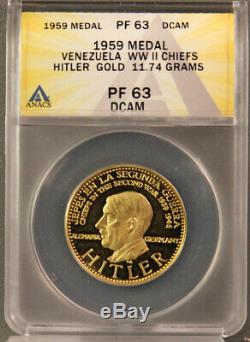
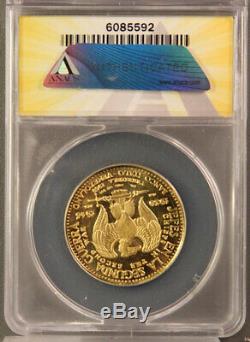
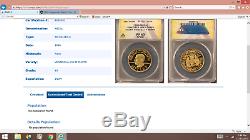
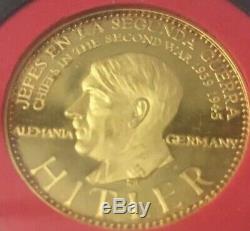

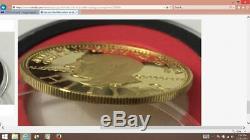
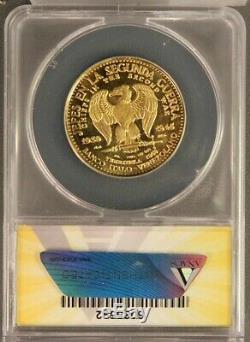
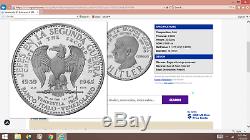


3 years have gone into the research of this medal Struck at the Baden Mint in Germany, issued by the Italo Venezuela Bank Unlabled double-error medal, if it was a coin it possibly could be labled as such Certified / Authenticated / Graded PF-63 DCAM by ANACS. They did have bolivares values depending on the gram weights stamped into them.
Referred to in several coin catalogs. The issuer referred to the medals as both medals and "coinage" on their packaging for the series.
ANACS is the oldest Third Party Grader (TPG), the first to grade and slab coins and medals and one of the top 3 TPG (NGC, PCGS, ANACS). Search ANACS on the internet or youtube if more information is wanted. A "Unique" in numismatic terms in that it is the only example known to exist in either planchet weight or omission of the gram weight.
You won't find one. Struck as part of the series known as the "CHIEFS IN THE SECOND WAR", consisting of 14-18 World War 2 leaders from both allied and axis powers which were issued in 1957, 1958 and 1959.
Its cousins in the series, in gold and differing gram weights/bolivares values, are listed in several "Coin" Krause and other catalogs. Gram weights are struck into the medals which establish their "bolivares" values. This medal does not have its gram weight stamped into it which would be normally considered an error if it were a coin..Error coins or medals are frequently desired by collectors and can substantially increase their value, perceived or otherwise. My personal opinion that, due to the unique chararistics of this medal, that it is an "experimental" strike.
It is possible that if any others were struck in the same ways as this medal, that they were either melted down or placed in the hands of other collectors. However, after some 60 years after being struck, it is highly unlikely that any others will appear, in the near or far future. No others have surfaced in the past. I do not use the term "RARE" in this listing or for any coins, because, in my opinion, it is a term that is way too overused by sellers, when they may or may not be rare at all. It comes down to what your definition of what "rare" is.
I prefer to use the terms "Scarce". This medal, with its differing features described in this listing, should rate as a "Unique" in nusismatic terms (one of a kind or the only known example). Eligible for PCGS crossover if desired.However, I cannot dictate to PCGS what they would put on the label. I had asked if they would list the errors, the PCGS representative said that since it is techinically considered a medal, they would not be able to do so. However, as I have said, there is inconsistency in this area and I have no idea of how they would label it other than the basic information and possibly that the medal was struck on a 11.7 gram planchet. All emails between PCGS and myself are available. Personally, I myself would problably not bother with it.
Not gold plated or filled medal, it is a 11.7 gram solid 22k gold example and is the only known example of its kind to exist in two different ways which could be considered errors if they were considered coins. Currently banned (for now)from NGC grading due to it bears an image of Hitler and a Swastika, however this is not always consistent.
Check the url in the last example image... It had been graded by NGC. It all comes down on the grader as far as how to handle or label the coin.
The swastika is on Hitler's collar. Banned (for now) from Heritage Auctions for the same reason, however this is also not always consistent. Otherwise, Stacks sometimes lists these medals and PCGS has graded several of these kinds (politically incorrect) of coins or medal in different gram weights, none in the 11.7 gram weight however... You can check their database for this. Grading and labeling is not consistent or a science among 3rd party graders (TPG)... Often depends on the individuals who are employed at the TPG whether a certain coin or medal is accepted or what the grade is... It is not unusual to see different descriptions, grades, rejections, etc. Between the same or different TPG for the same coin. 1959 was the only year of the proof medals. It is listed as being "not modified". This simply means that once it left the mint, it has not been modified. The values were determined by their individual gram weights. The gram weights determined their values in "bolivares" terms. It's cousins of differing gram weights and bolivares values are listed in the 2011 Krause Unusual World Coins catalog, 6th edition, under Venezuela X # MB6 (20 Bolivares), X # MB24 (60 Bolivares), X #MB160 (90 Bolivares) and X #MB60 (160 Bolivares). Its cousins of differing gram weights and bolivares values were also listed in the 2007 Krause Standard Catalog of Modern World Gold Coins, 1801-Present.Its 1957 and 1959 cousins of two differing years and gram weights were also listed in the 1981 R. Hyder catalog under C-401 1957 20 gram LEI 900 (finess) and C-402 (1959 50 gram LEI 900). Not all examples of all years of the series productions, grams weights or bolivares values or Krause numbers are in all Krause catalogs. Omissions are common in some catalogs or sources. However, there are no known 11.7 GRAM examples listed in any catalog, regardless of catalog brand, medal year(s), grams, charactors, etc.
Or by any individuals or any source whatsoever. This is considered the first possible error were it a "coin". I do not know if errors can be attributed to medals however. A large blank spot appears where the gram weight should appear for the 1959 examples.
This is a VERY significant chararistic of the medal. I can provide more information and images of the medal and its cousins if desired.I think this would come down to the decision of the grader(s) and not a company policy. As mentioned, grading, labeling, etc. Is not always an exacting or consistent science. This is believed to one of a kind unique and is struck by the same mint at the same time as the 1959 other gold coins in the series on a different gram weight or experimental planchet. The area where the gram weight would normally be engraved is on the lower part of the medal, just under the eagle's furthest right tail feather, right after the GR.
", right above the "EZ in VENEZUELA. There is just a big wide blank space there instead of the gram weight. Google other 1959 examples on the internet to see this.
The last image, a 1959 30 gram silver-colored example, is there so that you can see where the gram weight belongs. Please note that all of the reverses and some of the obverses (depending on the year and gram weight/bolivares values) were different. For 1959, in this 11.7 gram example, on the obverse on Hitler's collar, the hallmark is lower down, right under the swastika, the same as in the Krause 1957 / X #MB24 / 60 Bolivares / 22.2 grams. The hallmark is higher up on the collar on the 1959 30 and 50 gram examples because of mint design. It is considered a medal simply because they were not issued by the government, if they had been they would be considered coins. Nevertheless, they appear in several Krause COIN catalogs which are described here.. There are doubtless other coin catalogs which mentions the series. The definition of a coin is, under the Stacks definition, is A piece of metal of standard recognized value, issued under government authority, GENERALLY bearing a denomination and intended for circulation.In any case in which the medal is removed from its slab without my written consent, you will be considered the owner and no guarantee of any sort is provided. Modern testing equipment technology is available and commonly used by major coin shops or dealers to have the medal tested in seconds without having to remove it from the slab. I cannot specify to PCGS of what exactly what may appear on the label other than the basics and that it MAY include the phrase or indicate that it was struck on a 11.74 planchet. If it was considered a coin, it problably would have been listed on a pcgs label that it was struck on an experimental planchet, which is one of the more valuable errors.
It often comes down to who received the medal for grading. Grading and labeling is not an exact science and consistent wording or labeling is not consistent or standard between all TPG and themselves even in the same TPG.
The medal contains minor incuse planchet striations or die lines, there are sometimes several terms which describe the same conditions. Other terms to this effect may include die lines or die striations.
However, as such, these are not considered "problems" but many believe this is a somewhat semi-common issues by earlier struck proofs which are strongly struck, often to obtain a cameo surface, and are a result of the striking processes of the mint. Others may attribute die lines to the proof die itself, or the mint's post-strike polishing (or the lack thereof) for proof strikes, or a combination of one or more of these. The die lines are not very obvious to the naked eye on this medal. Many numismatic experts do not believe that minor die striations lower a coin's grade while some do. ANACS will accept a problem coin, however, even if they did, they are required to put the problem on the label.
This medal does not have any such problem(s) listed on the label. The following is from ANAC's website. "(Problem) Labels display a coins "detail grade and the coins corresponding problem(s). Details Graded coins are not eligible for the ANACS guarantee. Any cleaning by the owner is usually considered a big mistake if they do so and lowers the value of the coin and is required to be described as cleaned, harshly cleaned or otherwise stated on the label by the TPG who slabbed it, or any other problems as well.
All problems are legally required to be stated on the label by the TPG. This medal has no such designation. TPG grading individuals, of which there are usually 2-3 coin examiners, have to agree on the grade. However, since it is believed that there are no other known examples to exist and no other known examples to compare it with, the grade itself is somewhat moot and not unimportant in my personal opinion.
The medal itself is very attractive and shiny and considered "coin-like" or "so-called dollar" due to the bolivares value and details, of which there are so many I have not ever seen in a medal before and even more details than most coins. I believe this is why its cousins in the series often appear in coin catalogs rather than medal catalogs, however, this is my personal opinion. Other definations which may apply to this medal appear below, in regards to its strike, missing its gram weight, only 11.7 known example, etc. The glossary terms were obtained from the Stacks website and may be referred to online under their "glossary". To one collector, it could be little more than melt value.To another collector, it could be worth many thousands, depending on the collector and other factors which may or may not be consistent in the coin or numismatic world, which can be subjective to say the least. Most of the time, errors generally increase the value of a coin or medal, sometimes only a little, sometimes a lot. In any case, there is no doubt that it is a historic medal.
Catalog mistakes or ommissions are somewhat common with these. There were no 1960 issues. There were a number of Indian Chiefs series struck during this time frame, before and after, and sometimes people confuse the two issues or make incorrect judgements based on other factors because they are just simply (with no offense meant), ignorant or mistaken about the series, which is understandable due to the factors described in this listing.
When a coin dealer has hundreds of coins to sell, they often do not have the luxury of time to authenticate each and every complicated coin or medal. The medal contains the following in the test that I had it submitted to prior to encapsulation. AU - 92.58 - 92.80. AG - 6.08 - 5.97. CU - 1.34 - 1.23. AU is the periodic atomic term for gold. AG is the term for silver.CU is the term for copper. Hitler was obviously a monster and is considered my most as a politically incorrect character. However, in the numismatic world, even bad history is still history and cannot be changed and most numismatics or collectors do not have a problem with historic coins or medal, regardless of who is on them, and this is why several major TPG such as ANACS or PCGS will accept this medal for grading and/or crossover consideration.
Please note that the reverse strike design of each year in the series is different. Please message me with any questions or proposals. Low-ball offers will not be considered so please save yourself and me any attempts to do so. Trades may be considered, depending on what it is. Thank you for your time to read this listing.
Please take note that it is your responsibility to research this coin and verify what I have written here and to make your own final determinations, however, I doubt you will find out any more than I have in the last 3 years. Expect to find some omissions and confusion and outright just plain wrong information about the series because this is generally not a well known medal or series, however, you can be confident I have described the medal fairly accurately and completely. Note: because of my extensive research, there are images of this very medal on the web and in discussions on various coin websites. It should be noted that any images of such are mine, especially if you see a red packing ring around the medal.
This was in place around the medal before it was sent in for grading. Keep in mind that the medal can be crossed over to PCGS if desired, however, this will involve an additional cost and I cannot say or specify or know what they may put on the label other than the basics, however I can guarantee that it will not be listed with problems.
I spent many, many frustrating hours while researching this medal in an attempt to find another example of it in its gram weight and missing gram weight in a catalog or other publication or in anybody else's ownership of a similar medal until I finally came to the conclusion that the reason I was not finding any other examples was because no others are known to exist, at least in my investigations and on the net. If you do attempt to research the medal, you are likely to run into several images and websites discussions on the internet during my research, these are mine and there are images of it before it was sent in for grading, most of these have a red ring around it. If they do, it should be listed as a Unique and its value should rise dramatically. However, as stated, this medal is guaranteed to be authentic and is accurately described as above. At least one or more of the following terms included in the Stacks or other available glossaries which MAY apply to this medal include. Proof, Proof Dies, Polished Die, Pattern, Trial, Experimental Planchet, Planchet Striations, Error, Exonumia, Attribution, Sheldon Scale, Die Line, Die Striation, Die Trial, Die Variety, Blundered Die, Unique, Medal. Thank you for reading this listing. I have attempted to list basic information about this medal, however, I would be happy to answer any questions that you may have. Please note that this medal is returnable under the conditions listed above or if the medal is substantially or obviously is different as described from the information in this listing. This will be my and sole judgement to make. I have done my best to describe the medal. Please note that modern coin testers can test coins while still in the slab for types and percentages of metals and trace elements, etc. PLEASE DO NOT IGNORE THIS! I can't get rid of it on the listing. This is no medal to take any chances on. You may want to run this listing by your local coin dealer for an opinion, however, hardly nobody really knows about this series in a detailed sense more than I do and will likely be able to do not much more than attempt to locate it in a catalog.I have contacted sources in both Germany and Venezuela with no tangible results, as the mints/banks I believe have been closed and opened at times. Any person who might know the true story of this mysterious medal would be long-retired by now and at least 80 years old.
The medal's value, in it's present form, is not subject to any suggested price guides that may exist. It is suggested that you contact me before purchasing the medal with any questions, concerns or proposals. Look carefully at the images here and on the web for other 1959 images that include the area where the gram weight should be. The reserve has been put high so that you have the time to ask any questions, investigate the medal to your own satisfaction and make an informed decision. Lowball offers will be automatically rejected. This medal is without a doubt, in my experience the most controversial and interesting coin or medal that I have ever owned or offered for sale. Altho I usually keep whatever is in my collection, if you will message me with what your particular interests are with world coins or medals, I may have something you may be interested in.I have graded and ungraded coins or medals. This medal, by far, is the most unusual and scarcest medal I have ever collected and was the most difficult to research, mainly due to the amount of ommissions, misunderstandings or misinterpretations of the series, misinformation and other factors. This is just the tip of the iceberg.
There are "competing" Venezuela issues during these years from other mints and Venezuela banks which have completely different designs which are currently on the internet. There are several more examples of these types of issues. However, in any case, the medal offered here is authentic and certified and is guaranteed to be the real McCoy. Take your time and do not hesitate to ask me any questions or any other matters.
The item "1959 Solid 22K Gold Medal Not Coin, Venezuela, Adolph Hitler, 11.7 grams, Unique" is in sale since Sunday, February 16, 2020. This item is in the category "Coins & Paper Money\Exonumia\So-Called Dollars".
The seller is "4504" and is located in Clovis, California. This item can be shipped to United States.
- Modified Item: No
- Country/Region of Manufacture: Germany
- Circulated/Uncirculated: Uncirculated

